It was about a decade ago when I saw an ad for the e-holster. At the time, I was stuffing my pockets with a PDA, cell phone, keys, etc. and needed a better way of carrying all of these gadgets. The e-holster was just right.
I got my first one in 2001 and have worn one ever since. I have had to buy new modules over the years to accommodate the different gadgets. Over the past year, I have replaced all of the components.
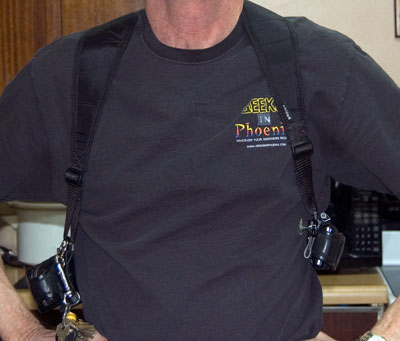
Front of e-Holster
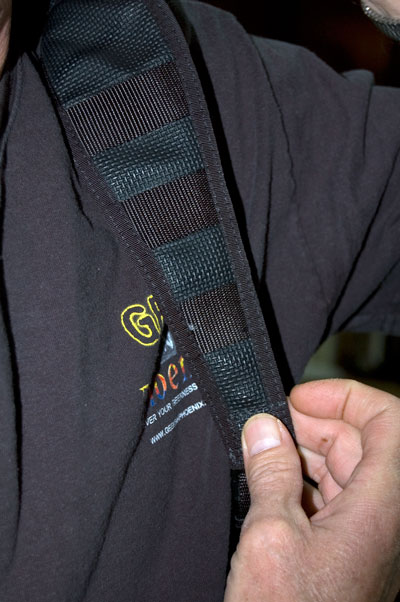
Inside of e-Holster
The leather shoulder holster had started to show its age, so I went with the nylon version. It also has loops for wired headsets, where the leather one did not. And the Android phone and new eyeglass case size required the purchase of new case modules (leather).
a8f13e54-bf4d-424a-ab8f-bd454d944e9d|0|.0|96d5b379-7e1d-4dac-a6ba-1e50db561b04
In my Geek Tips article outlining my Beta test of Microsoft Windows 7, I needed a computer to install it on. What I built is sweet, specification wise, but the case steals the show. Still, photos do not do this case justice, so here's a video. Check out the Geeks in Phoenix Windows 7 test system inside the Antec Skeleton!
350db973-aef5-411e-ad77-6963634f139c|0|.0|96d5b379-7e1d-4dac-a6ba-1e50db561b04
As many of you know, I'm not your 'pocket-protector' type of geek. For years I have been asked, "Is that a holster you're wearing?"
Actually, it's an e-Holster Modular Shoulder Holster Case System.
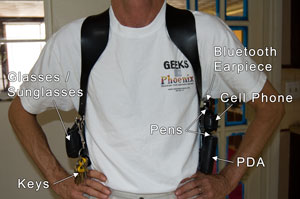
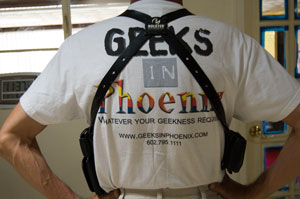
I found that I could carry everything I usually would stuff into my pockets without getting the 'clown pants' look (over-stuffed pockets). This is my current configuration, as these are modular components.
30324ecc-9a64-45c7-ab54-c811ca13abbd|0|.0|96d5b379-7e1d-4dac-a6ba-1e50db561b04
Here are the pictures of my daughter's finished customized computer case.
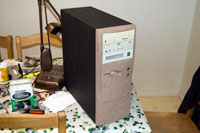
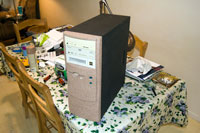
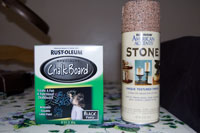
The face is RUST-OLEUM's American Accents 'Sierra' Stone textured finish. The top and sides are RUST-OLEUM's Chalkboard specialty paint.
Pretty sweet, Brittany! Can't wait to see how you decorate it with chalk.
a5781646-4ae4-402e-abeb-3505db8d0a48|0|.0|96d5b379-7e1d-4dac-a6ba-1e50db561b04
With newer computers having the ability to run multiple displays, here is a ‘Geek Tip’ for those thinking about using two monitors on one computer. There are various scenarios; I am going to describe just a few. I currently have two systems here with dual monitor setups.
Of course, there is the side-by-side scenario, either horizontally or vertically, with the desktop expanded across the monitors. The first thing to consider is having two monitors precisely alike. It’s not necessary, but it is recommended. With this setup, you can work with a different program on each monitor. Makes copy and pasting a breeze. And you can also stretch a program across both monitors (left monitor has a work area; the right monitor has the tool palette).
This scenario also works well for those with visual impairments that require a magnification utility. You can use a larger monitor as the ‘main’ display and a smaller monitor as the ‘secondary’ display. Using the main display for all standard functions, the secondary display shows a magnified view of the main display. And without the need for matching monitors, you could pick up a cheap used one to run as secondary. Try your local Goodwill, Savers, thrift shop, etc.
Then there is what I like to call the back-to-back scenario, with the monitors on opposing faces of a wall or walls. The keyboard and mouse can be used wirelessly or through a USB cable. Yes, you can run more than one keyboard and mouse on a system, if this helps. In this case, cloning the display across both monitors is required, as the user can only view one monitor at a time.
With this scenario, you can have a presentation monitor (LCD or plasma TV works well) on one wall and a standard monitor at the workstation. The variations on these scenarios are vast, and I hope I have inspired you to look into using dual monitors.
870ed2a6-ad45-43d1-b47e-011f380d045b|0|.0|96d5b379-7e1d-4dac-a6ba-1e50db561b04